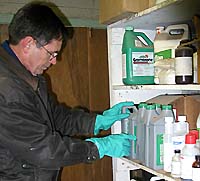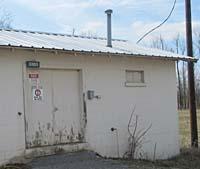Pesticide Storage Important in Winter
Pesticide Storage Important in Winter


Pesticide storage facilities should be well ventilated and marked with correct signs at the entrance.
In the midst of below-freezing temperatures and other winter weather, homeowners and farmers may not think there’s much reason to pay attention to pesticides. However, pesticide storage is important, especially during winter.
“Safety is the primary concern so that products are kept out of the reach of those who should not come into contact with them and there is little chance for spill and damage to the packages and containers during the winter,” said Lee Townsend, entomologist for the University of Kentucky College of Agriculture. “Second, you’re trying to protect your investment in the products you have. If they are stored properly, most can last for at least two years on the shelf and still function effectively.”
Townsend said the best way to store pesticides on the farm is in a sound building on a concrete block. The building should be well ventilated since fumes can build up from chemicals stored in areas with stagnate air. Also, storage temperatures may be important.
“Sometimes the label will have specific information about storage temperatures,” he said. “Some say not to store the product below 40 degrees, while others are as high as 50. So, that means having at least a partially heated storage area.”
Another important storage aspect is to keep pesticides out of reach of children and animals. Townsend said having a storage facility that locks is the best way to keep products away from unintended people and animals.
Good shelving also is important so products are not stored on the ground.
“Sometimes we get heavy rain and flooding during the winter months,” Townsend said. “That can translate into water in the storage area. Make sure you have supplies on hand to clean up any spills or accidents in a timely manner.”
Townsend said it is very important to have signs on storage facilities that indicate it is a pesticide storage area. Some signs even give a warning about fire hazards. Fumes from chemicals in a fire can be very dangerous to anyone around, especially those battling the fire.
Winter also is a good time to take inventory of all the products in the storage area.
“It’s always good to have a list of the products you have on hand,” Townsend added. “That way when you go to purchase chemicals for next year, you will know what you need.”
Check products in storage and make sure they are not expired. Examine the packaging for damage and make sure the label is still readable.
“If it’s a little too humid, packaging can deteriorate,” Townsend said. “Most of the products now are in plastic containers and they generally keep well, but it’s still good to check. “
Products in cans have some special concerns – rust and swelling. A swelling can has a pressure build-up that needs immediate attention.
Townsend said it’s a good idea to always keep protective equipment on hand like gloves and eye/body wash solutions in case of emergencies.
Homeowners may not have specific storage buildings for pesticides and typically they don’t buy pesticides in significant quantities, but storage still is important.
Townsend said homeowners could at least put products in the garage and get them up out of the reach of children.
“Make sure you know the dates on your products,” he said. “Use the oldest ones first and make sure you follow the label instructions for disposal.”
On the farm or in the home, pesticide users may occasionally see products with telltale signs of ineffectiveness. Powdery products may start to clump and liquids may separate.
Before disposing of the product, read the label to see if there are suggestions for correcting it. Sometimes rolling a bottle or shaking a product will help, but make sure the label allows these techniques before employing them.
Townsend said that due to the Food Quality and Protection Act, passed by Congress in 1996, homeowner uses of Dursban (chlropyrifos) and Diazinon are being phased out. In some situations, chemicals are only discontinued for homeowners and have become restricted-use pesticides for certified applicators. Farmers may still be able to use them if they go through pesticide applicator training provided by the Cooperative Extension Service in their county.
Homeowners who have products containing phased out chemicals can use the product according to label directions until it is gone. Townsend said it is better to use them up because the longer you keep them, the longer they have to become a disposal problem.
“New replacement products will be on the store shelves to replace discontinued products,” he said. “These products will do the same tasks and also be safer for humans and the environment.”
The most recently discontinued chemical is Diazinon. The U.S. Environmental Protection Agency announced an agreement to phase out Diazinon, one of the most widely used pesticides in the United States, for indoor uses beginning in March 2001 and for all lawn, garden and turf uses by December 2003. Commercial products always have a list of active ingredients on the label. Check this list for the discontinued chemical. If you have any questions, contact your local county Extension office.
